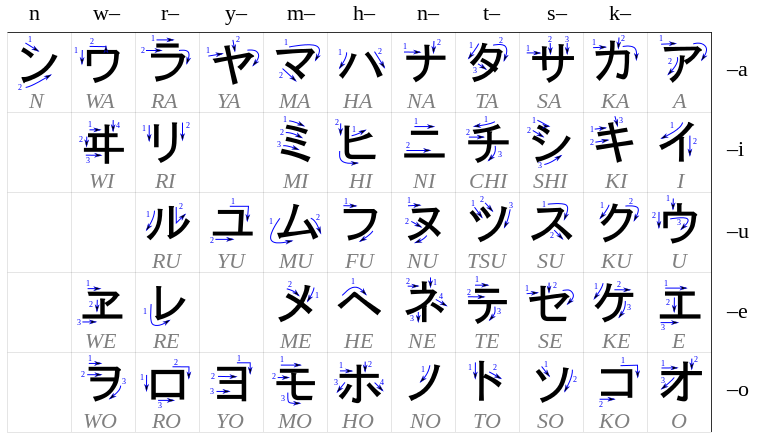Basics of the Japanese language

Let me preface this by saying I have barely scratched the surface on learning Japanese and while I can’t guarantee that everything below is 100% correct, it is to the best of my knowledge.
A year ago I knew nothing about the Japanese language. I couldn’t tell the difference between Chinese and Japanese and the only words I knew were hello and thank you. Since then I’ve gotten considerably better and while I’m nowhere near fluent, I have learned a ton in the past nine months.
Learning the intricacies takes years of studying, but one can pick up the fundamentals pretty quickly.
Basically, Japanese has three alphabet systems.
- Hiragana – used for native Japanese words. 46 characters. Example: さ ひ に
- Katakana – similar to hiragana, but only used for foreign words like computer, email, code deploy, martini, etc. katakana is more angular than Hiragana, and each character has a matching hiragana. 46 characters. Example: サ マ ア
- Kanji – Based on Chinese characters. Each one is complex and represents a word rather than a sound like hiragana or katakana. Over 50,000 exist but only 3,000 are used commonly. Example: 腺 漢 字
The first step to learning Japanese is learning hiragana and katakana, known together as kana. Much like learning the ABCs, each character corresponds to sounds in the Japanese language. You combine different kana to pronounce Japanese words. See the hiragana then katakana chart below:


If you wanted to write something in Japanese using hiragana, you would simply spell it out. Take ‘sushi’ for example. You select SU (す) and SHI (し), combine them to form すし. Or つなみ = TSU-NA-MI or tsunami.
The next step is memorizing kanji – a tedious process that is simplified by some characters looking similar to what they represent.
I’ve memorized about fifty or so, but haven’t gone much further. It’s difficult because you have to memorize the character, the pronunciation, and the corresponding English word. If you want to be able to write them, you need to memorize the stroke order too. And in many cases each kanji has multiple pronunciations. As I said, it’s a difficult language to learn.
Grammar is also confusing. Verbs don’t distinguish between future and present tense, there are no plural forms of nouns, and the sentence structure can be confusing.
For example rather than saying ‘I went to the movie with my friend’ you would say ‘Friend with movie went (I)’. Direct objects (friend) tend to go first and verbs are at the end with the subject not always being explicit. It’s hard to get used to.
One of the most difficult things to understand is counting nouns. You don’t say a number followed a noun, like “three people” or “two beer bottles”. Instead you need to use a counting modifier based on what you want to count, like people or two cylindrical objects. You count thin flat objects differently than counting people which is different from counting months which is different from counting animals, etc.
Confusing? Yeah…this does a good job of explaining it: http://www.tofugu.com/guides/count-anything-japanese/
Unfortunately, the usefulness of studying Japanese is pretty limited outside of Japan. Outside of a sushi restaurant or translating Most Extreme Elimination Challenge, I’d have no idea where to even encounter Japanese on a regular basis outside of work. Right you are Ken.
So I don’t plan on continuing studying when I get back to the US. The cost-benefit just isn’t there. For those interested in Japanese, I’d suggest learning a small amount as 20 hours of studying can help tremendously. But outside of that, unless you encounter Japanese on a daily basis it’s probably not worth it.
